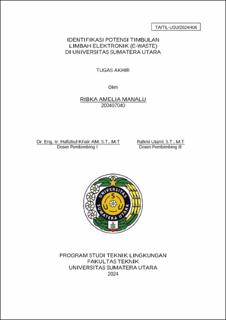| dc.description.abstract | Higher education institutions (universities) contribute greatly to the rapidly growing threat of e-waste. The University of North Sumatra is one of the major e-waste generators in Medan City, due to the use of a high number of electronic devices to support the learning and operational processes at the university. Data on e-waste generation at the University of North Sumatra is currently unknown. In addition, the University of North Sumatra is a university that implements a green campus, where USU has the capacity to develop sustainable science which requires the support of an environmentally friendly campus environment. The sampling technique used in determining the object of this research is Random Sampling. Data processing carried out in this study is to calculate the estimated amount of potential electronic waste generated and analyze the Material Flow Analysis scheme at the University of North Sumatra. In this study, mixed data analysis (quantitative and qualitative) was used. The highest potential e-waste generation in the ICT equipment category is PC with a weight of 75547 kg, the highest potential e-waste generation in the household equipment category is dispenser with a weight of 19093 kg, the highest potential e-waste generation in the temperature exchange equipment category is air conditioning with a weight of 2029960 kg, and the potential e-waste generation in the lighting category is lamps with a weight of 477210 kg. The potential electronic waste generation of the University of North Sumatra in 2034 per category that has the highest percentage is temperature exchange electronic equipment with a percentage of 74.2%. Followed by electronic equipment for lighting 16.5%, ICT electronic equipment 7.7%, and household electronic equipment 1.6%. Factors that cause the potential generation of electronic waste at the University of North Sumatra in the non-domestic sector and the domestic sector, namely the age of use of electronic equipment that has passed the productive age, the behavior of using electronic goods (using electronic goods excessively and electronic goods that are very rarely used), lack of maintenance of electronic equipment, and the effects of increasing electronic goods technology which causes consumptive behavior to buy new goods due to the decreasing quality of goods. The material flow of damaged electronic goods at the University of North Sumatra in ICT electronic equipment 64% are stored, 12% are disposed of, 12% are sold, and 12% are donated. Household electronic equipment 17% were kept, 18% were sold, 17% were discarded, and 48% were donated. Temperature exchange electronic equipment 14% were kept, 14% were sold, 15% were sold, and 57% were donated. Electronic appliances for lighting 100% were disposed of | en_US |


